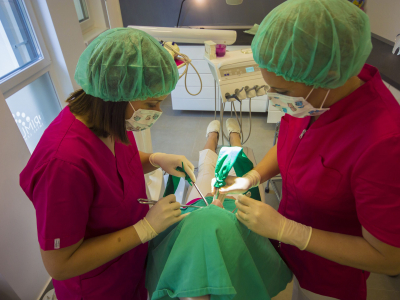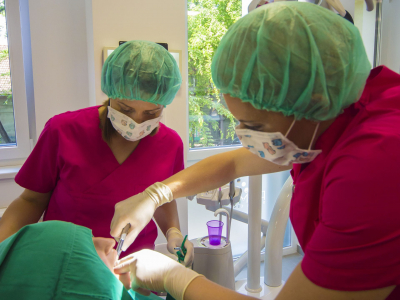Oral surgery is a special field of dental medicine which deals with
Oral surgery includes all forms of oral cavity intervention, such as:
- Tooth
extractions - Surgical tooth extraction (extraction of wisdom teeth, canine and dental roots)
- Apicoectomy
- Cystectomy
- Cistektomije
- Pre-prosthodontic surgical preparation
- Implantology
- Sinus
lift - Frenulectomy
- Surgical preparation of orthodontic therapy
- Jaw ridge augmentation
Tooth extractions
Despite the fact that permanent teeth are supposed to last a lifetime, there may be situations when tooth extraction is unavoidable. Often the tooth is too badly damaged, either from trauma or
Following tooth extraction, patients should avoid smoking and take care to brush their teeth regularly so that the wound can heal well. You can accelerate the healing process by placing a cold pack on the affected section of the face.
Our goal is to make all necessary surgical procedures pleasant, safe and most importantly – painless
Apicoectomy
Apicoectomy or root end resection is a minor oral surgical procedure whereby
Surgical tooth extraction
This is one of the most common interventions in dental
Impacted teeth are teeth whose growth path is blocked, so they are formed completely within the bone and cannot find their way into the tooth line.
Usually, these are the upper and lower wisdom teeth, because there is not enough space in the jaw for them to grow, they assume an irregular position, pressing down on the surrounding teeth. This is likely to cause pain and may lead to infection.
Given our professional approach, experience
Cystectomy
The cystectomy can be described as a possible therapy of a cyst. Cystectomy is actually the removal of a cyst, i.e. the scraping out of the cyst cavity. During such an intervention
Sinus lift
Sinuses are found in the upper jaw, they are actually air-filled spaces. When the molars have been missing for a longer time, these sinuses move lower, so that there may not be enough bone left to perform the necessary implantations.
However, we can achieve great surgical results with the sinus lift to raise the sinus floor.
Jaw ridge augmentation
For a successful
After such an intervention, the patient has to wait at least 6 to 8 months to ensure that the healing process is complete. We can start with the implantation after that.
Frenulectomy
This is a smaller surgical intervention in which we remove the frenulum to make sure that the prosthodontics will fit better. Some of our patients have a thicker frenulum, which spreads deep between the teeth and may have negative impacts:
- Creating a diastema
- Gum recession
- Repeated teeth separation following the prosthodontic therapy
We recommend
This diastema is then closed using a fixed prosthodontic apparatus, and following the completed prosthodontic therapy, we perform a
This intervention also happens in local anesthesia, so our patients remain completely
Hemisection
The hemisection and dissection of the tooth refers to a surgical removal of the diseased incisor root so that the health root section can be in prosthodontic therapy
Pre-prosthodontic surgical preparation
Surgical preparation of prosthodontic therapy includes the preparation of soft and hard tissue of the oral cavity to ensure a successful functional and aesthetic prosthodontic rehabilitation. These include the surgical measures for structure preservation during tooth extraction.
- Taking steps to preserve jaw volume after tooth extraction
- Surgical enhancement of clinical tooth crowns
- Gingival enlargement
- Recession coverage (of
exposed dental cervix) - Tissue preparation for implantation
In the healthy jaw, the tooth root is fully ‘anchored’ in the jaw bone, safely surrounded
Gingivitis left untreated can cause periodontitis. Due to inflammation, the gums become swollen and detached from the dental surface. This creates small pockets which tend to grow and be a hotbed for bacteria. The surrounding tissue reacts to the bacteria by becoming inflamed. As a consequence, the inflammation causes the deterioration of both the supportive tissue, as well as the bone. Periodontitis often does not present noticeable symptoms, but with time, the inflamed and increasingly deteriorated bone will lead to loosening and eventual loss of the tooth.
Although we can successfully replace any missing teeth with dental implants, these implants can only be used if the bone has been sufficiently treated and augmented to make sure the implantation will work.


